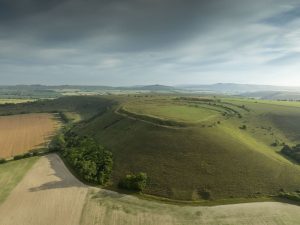History

White Sheet Hill Fort – photo credit: Charles Sainsbury-Plaice
The archaeological timeline here stretches between a Neolithic meeting place and a 1950s nuclear-fallout monitoring station. Spaced 500m apart along the crest of this curving hilltop are three ancient earthwork enclosures, each 200–300m in diameter.
The middle enclosure is the oldest, dated by excavation to over 5,600 years ago. Here, some of the earliest British farming families gathered, perhaps for ceremonies and to prepare their dead for burial. These sites are known as ‘causewayed enclosures’, because their boundaries were built as a series of ditches interrupted by gaps or causeways.
This site was later cut by a medieval cattle drove, still used as a routeway. Across this track to the north is a rare type of circular enclosure. It was probably built about 5,000 years ago, contemporary with the earthwork surrounding Stonehenge.
Along the southern edge of the causewayed enclosure are four Bronze Age burial mounds, built 4,300–3,500 years ago.
The southern enclosure, on the far side of the hill, is an Iron Age hillfort, built on land already separated from the rest of White Sheet Hill by an earlier form of defence known as a ‘cross-ridge dyke’. These are typical of the Late Bronze Age, constructed 3,000–2,800 years ago.
The hillfort was probably built about 2,500 years ago as a single rampart and ditch. Later, two more lines of defence were added to the north, where the ground is level and more vulnerable to attack. Traces of Iron Age round houses show that people once lived within the hillfort.
Countryside Code
Respect everyone
- Leave gates as you find them.
- Do not block access to gateways when parking.
- Be polite to others and share the space.
Protect the environment
- Take your litter away with you – this includes dog poo!
- Keep dogs under control and in sight.
- Care for nature and don’t cause any disturbance.
- Do not light fires or BBQs.